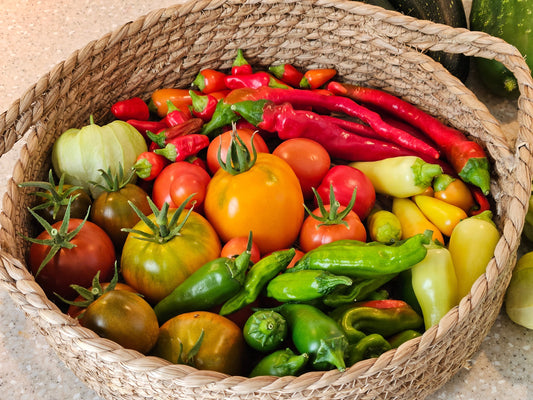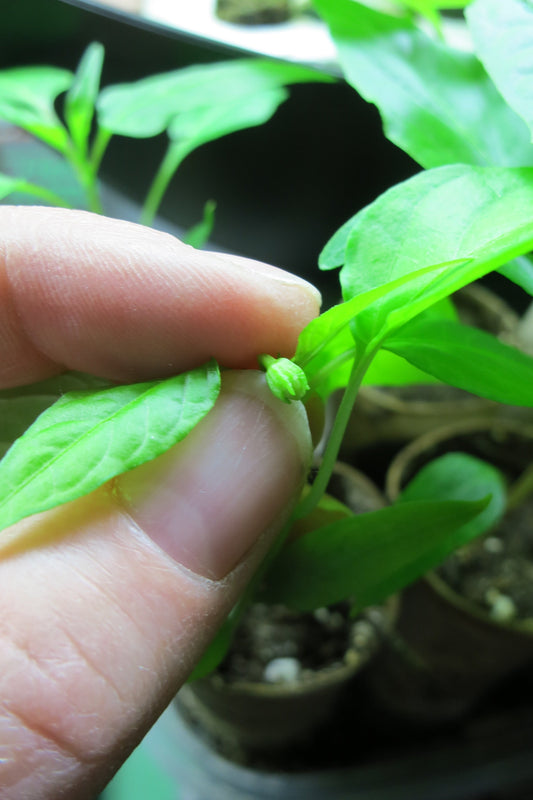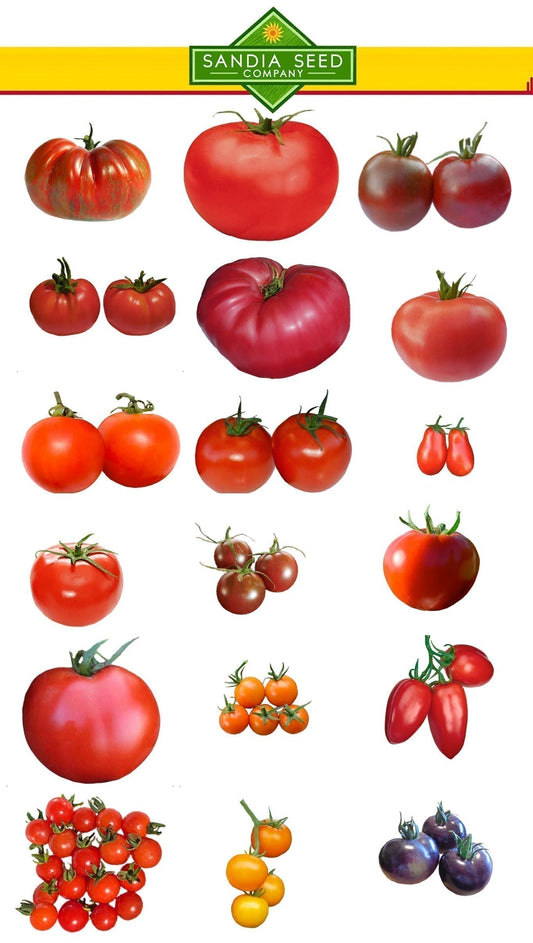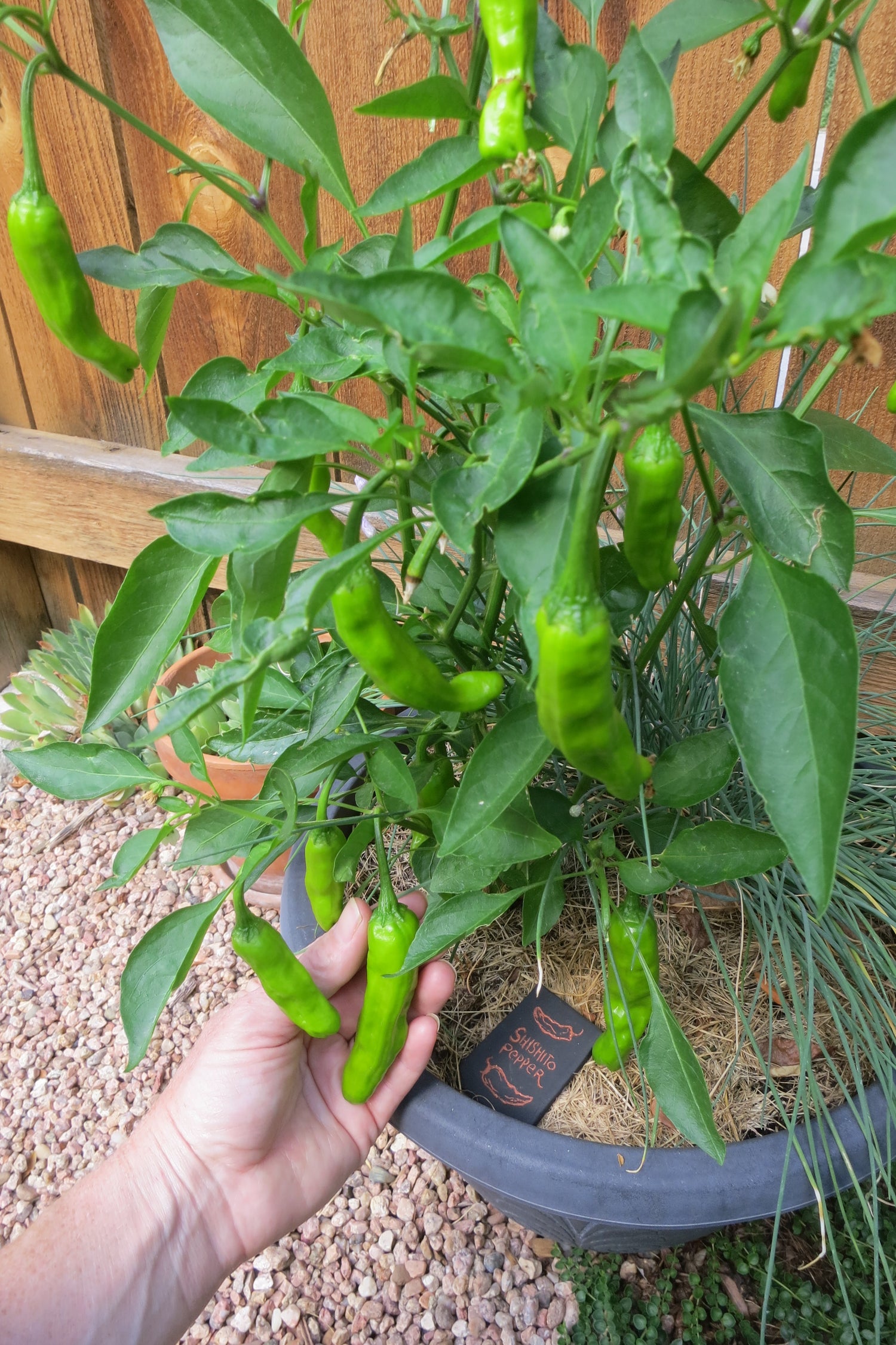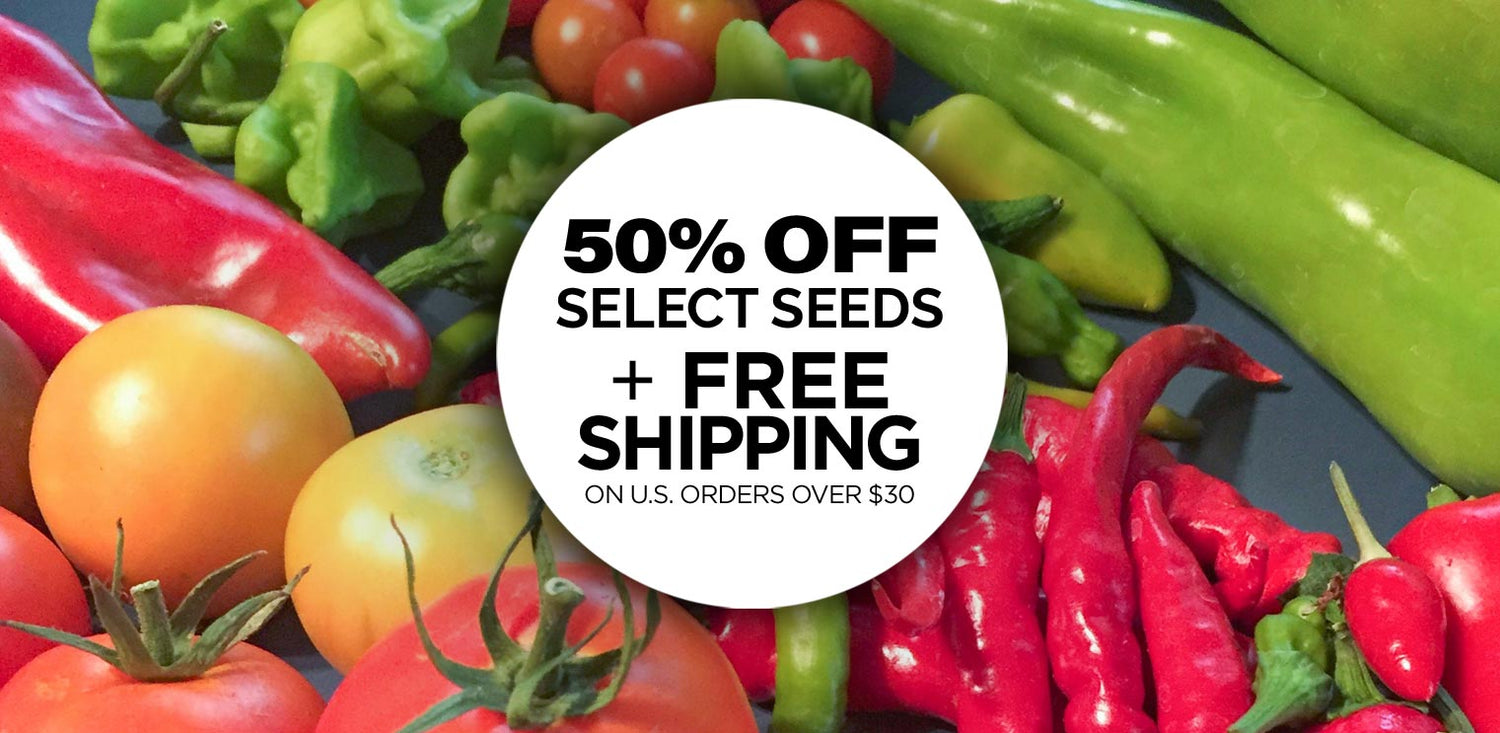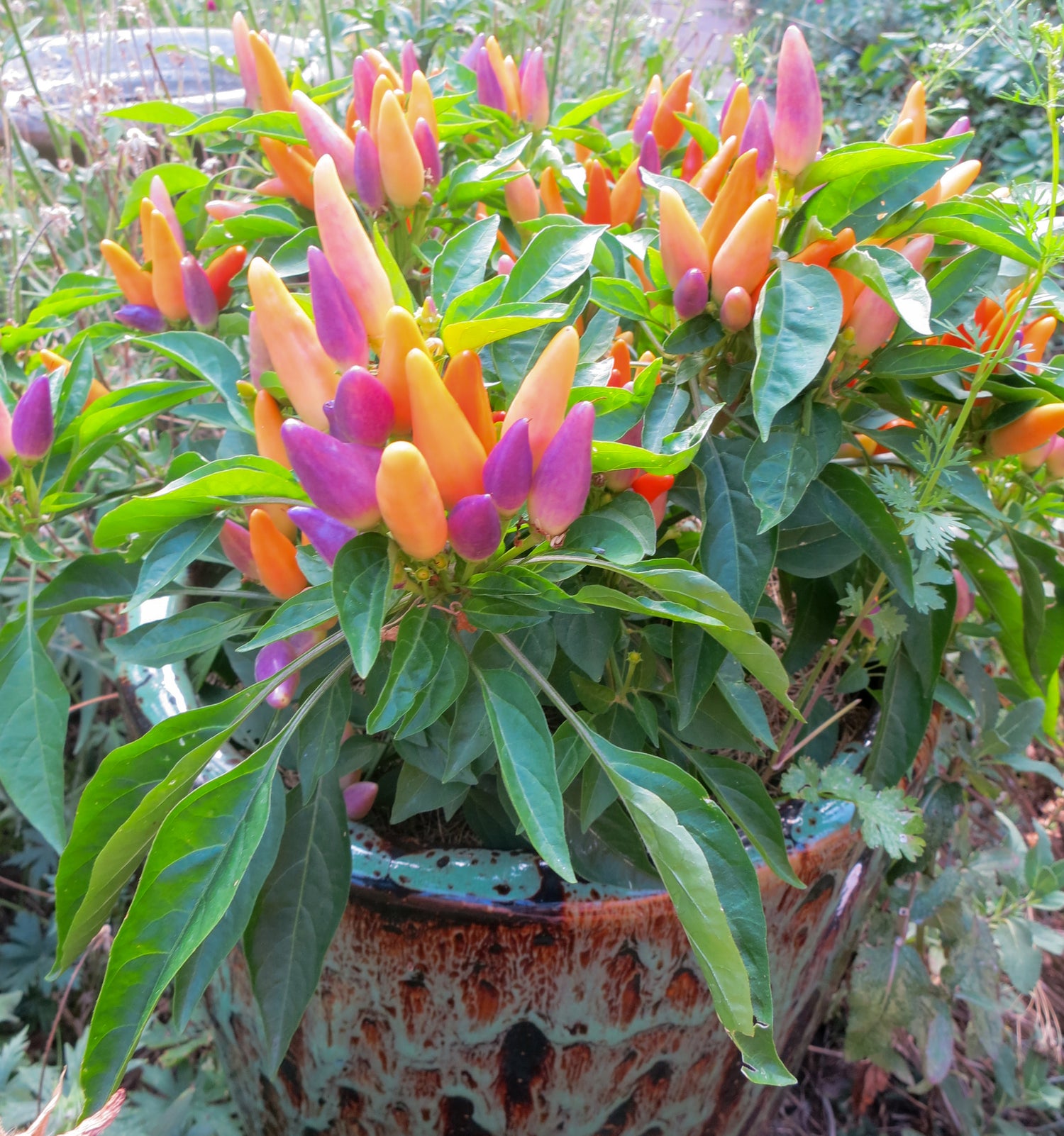We think that some of the best vegetables to grow in Colorado are Chile peppers and Tomatoes.
We of course love growing all other vegetables as well including zucchini, squash, pumpkins, herbs, eggplant, and cucumbers of course, for making spicy pickles with the hot peppers! But tomatoes and peppers are hard to top.
Any Colorado vegetable garden is likely to include several varieties of peppers and tomatoes, they bring such a wide variety of flavors and colors to the garden.
Just think about all the different peppers you can grow – with Colorado's hot and dry weather, you can grow lots of New Mexican chile seeds that are famously called Hatch chile. Technically you can't call them "Hatch" chiles unless they are grown in the Hatch region of New Mexico – but don't let that stop you from growing them. Homegrown green chile is the best, you can pick it fresh and roast it outside on the grill the same day for the best tasting green chile that you just can't buy at a store.


The Mosco chile peppers shown above are the most delicious pepper you can find north of the NM state line. This Mirasol chile from Pueblo, Colorado is very meaty with a sweet flavor and medium heat. This red Colorado chile will make the best red chile sauce you have ever tasted!

The Giadone chile peppers shown above are one of the most delicious peppers you can find north of the NM state line. This Mirasol chile (Mirasol means looking at the sun as they grow upward towards the sun) is from Pueblo, Colorado and is very meaty with a wonderful sweet flavor and nice hot heat with a Scoville rating from 10,000 - 12,000 SHU.
If you like spicy, also of course try any of our Jalapeño seeds, which come in several colors including our Yellow Jalapeño seeds shown above, and Orange Jalapeno seeds. Or if you want it even hotter, check out all of our Super Hot Pepper Seeds so you can grow the hottest pepper in the world from our Carolina Reaper seeds, or check out all of the other super hot peppers that will give your hot sauce or salsa a killer burn.
Sweet peppers are also a wonderful addition to your summer garden in Colorado. Some of our favorites are Shishito pepper seeds which produce a lot of sweet savory peppers all summer long, or try our Purple Bell Pepper seeds, or our super sweet and cute Mini Orange Bell Pepper seeds that will have abundant peppers that you will eat right in the garden for a sweet crunch.
We also have a wide variety of beautiful and delicious Heirloom tomato seeds as well as Hybrid tomato seeds. Growing the Cherokee Purple Heirloom Tomato seeds is rewarding as you get huge dark juicy tomatoes that taste like heaven. Our Indigo Rose Heirloom tomato seeds are gorgeous in indigo and are super tasty, too!

Colorado can be a tough place to grow Peppers and Tomatoes:
Our Colorado seed customers have had a slow start this year with lots of cold nights, hail, and even a late snow storm! Here are some photos a customer sent in – she said that these chile plants, planted a month ago, haven't grown much at all since transplanted. But, the heat has arrived, so they'll take off now! You can see the Shishito's side shoots that are about to launch! That plant was in a Water Wall during the cold weather of late June and early July, and it seems a lot happier than the Chimayo who was left out in the cold. Glad the heat is here to help them along.
Tips for growing the Best Vegetables in Colorado:
Start peppers indoors early, but make sure they have enough room to grow until mid-May to early June, after the temperatures have warmed to at least 60˚ F at night (which we know, in Colorado, there is often 40-50˚ F nights often in May and June!). Waiting to plant them outside until after the soil has warmed up will speed their growth, while planting them earlier when there are still cold nights you may see stunted growth until the heat comes to stay.
A lot of Colorado gardeners report great success growing peppers earlier by starting them in plastic hoop houses to help heat the bed with solar energy. Water Walls are also used (water filled walls that surround your plants) which keep peppers warm, especially on cold spring nights. Tomatoes also like warmer weather but they aren't quite as sensitive to cold nights (below 50-60˚) as peppers are. 
Grow Companion Plants:
In the early spring in Colorado, it's good to also grow Pepper Plant Companions like perennial herbs such as Thyme, Oregano, and Chives, as well as cold-weather loving veggies like lettuce, kale, spinach, radishes and onions. When you grow these veggies and herbs in addition to your peppers and tomatoes, then you get to reap harvests throughout the season! We also love to grow lots of native flowers to encourage pollinators and beneficial insects and birds to visit our garden. 
Companion Plants for Pest Control:
Birds and insect predators are excellent pest control, so keeping a clean filled bird bath and growing flowers that birds and insects love like Sunflowers, Coneflowers and other seed-heavy flowers will encourage them to visit your garden and eat pests like armyworms, tomato hornworms and cutworms. By planting lots of native flowers, you will invite beneficial predators and insects to your Colorado garden which will help keep pest populations under control. The more Ladybugs, hoverflies, wasps and praying mantises you have, the better, as they eat eggs, larvae and adult pests.
Learn more about Plants that Attract Beneficial Insects »
Above is a Colorado-grown Shishito sweet pepper that has had a slow start this spring due to cold weather including snow and hail, but with a little cover it has survived what mother nature threw at it and it's now about to take off since the July heat has arrived. 
Above is a plant grown from our Purple Bhut Jolokia seeds, and boy it was loaded with peppers. Unfortunately, an early snow came (as it often does in Colorado), so this seed customer picked the rest to bring inside, luckily before any frost damage was done. Some Colorado gardeners will erect hoop houses and cover with plastic before early snowstorms to keep their peppers, tomatoes and other veggies warm to extend the growing season. Super hot peppers do take a long time before ready for harvest (100 days or more) so starting them early indoors and using covers for early snowstorms in the fall can help you get the most peppers out of your plants.
Also, if you pick peppers before they've ripened (if they're close to ripening), they will usually ripen on your counter. We've seen tons of peppers turn red or purple after they are picked. And, peppers are actually edible in their early stages as well as their fully ripened stage, so feel free to pick and taste them anytime throughout the growing season. If you pick a pepper and it tastes "green," then just wait another week or two and try another one until it has the flavor desired.
Show us your Colorado Vegetable Garden!
Tell us how your chiles are growing! Are you having a slow start, too? Tell us where you are gardening and what you're growing. ![]() You can share your photos with us on Facebook or hashtag us using #sandiaseed on Instagram.
You can share your photos with us on Facebook or hashtag us using #sandiaseed on Instagram.
Here's a good conversation about growing vegetables from some gardeners in Denver, Colorado:
Question: So I am starting my cucumbers, zucchini this month (April) as I know they can be resistant to cold, but I was wondering if I can plant tomatoes, and peppers as well? If not, are there certain ones that you can and can't plant until it is warmer?
I start pepper and tomato seeds indoors this month, and I wouldn't put anything outside yet without a greenhouse or hoophouse combined with water walls or jugs of water... which also could freeze if we had too long a cold spell. But you can always try if you're starting from seed! I may put out a pepper seedling "test subject" into my hoop house in the next couple weeks with water walls and see what happens. I don't think they'll freeze in the hoop house, but I'll try one and see. I have found that water walls allow me to plant my peppers in early to mid-May, and it protects them from the late May cold spells and even hail (you can teepee them closed).
Most peppers I've found get stunted if planted too early without protection, I've now been planting them outside in early June rather than mid-May, as I've found that our springs are quite cold in late May, and my later planted pepper and tomato seedlings do way better in the long run.
The spicy Orange Rocoto pepper does well in cooler temperatures (still doesn't like freezing though), and also Bulgarian Carrot Peppers (also spicy). Or try the super early Sweet Chocolate Bell pepper. For tomatoes, you could try the New Yorker Heirloom Tomato.
Check out the Fastest Growing Peppers where they feature lots of varieties that are fast growing for quicker harvests.

And one last note: For pumpkins, squash, zucchini and cucumbers, I also direct seed them in mid-May vs. starting them indoors as I find they get root bound if started too early, and the ones I direct seed into mounds in the garden in mid-May take off faster and are healthier in the long run than earlier-indoor-started seeds. You could start them a couple weeks before transplanting, just don't let them get rootbound.
And that's a wrap.
Happy Growing, Colorado Gardeners!






